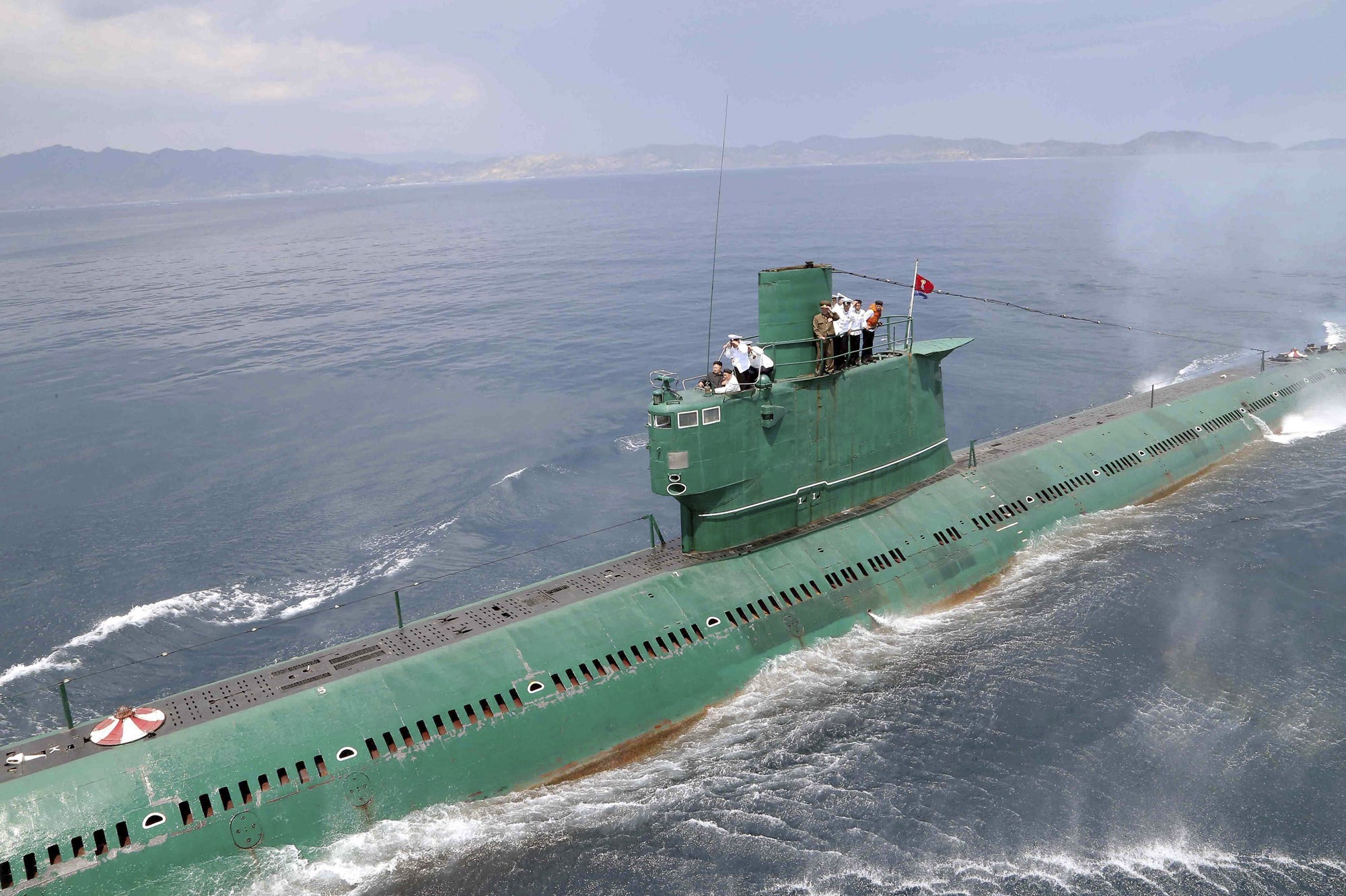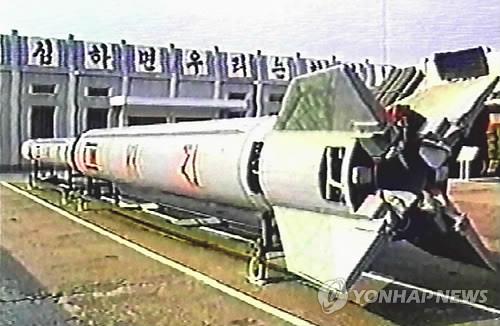Signs point to Kim Jong Un developing nuclear-armed boomers
North Korea is attempting to put nuclear weapons to sea, according to a longtime regime watcher.
Joseph Bermudez—an expert on North Korean weapons—believes the evidence
is commercial satellite imagery showing a submarine with possibly two
vertical launch tubes. The regime also appears to have constructed a
test stand for launching sea-based ballistic missiles.
The two revelations may not be directly related.
For
one, the vessel might not end up carrying nuclear-capable missiles. But
Bermudez’s evidence is highly suggestive. And if the North is planning to put nukes aboard submarines, this would make Kim Jong Un’s atomic arsenal more survivable in case of attack.
In October 2014, Bermudez observed an unidentified submarine
at North Korea’s South Sinpo Shipyard. The shipyard conducts research
and development for naval weapons and warship construction.
According
to Bermudez, the submarine appeared to weigh around 900 to 1,500 tons
in displacement. The analyst tentatively nicknamed the
still-under-construction vessel the Sinpo, and noted a resemblance to former Yugoslavian submarines.
Intriguingly,
satellite imagery from July 2014 revealed an empty space near the
conning tower. Pyongyang could install one or two vertically-launched
missiles in this space. The shipyard also has a nearby test stand for
the development of long-range ballistic missiles.
The
stand is “the right size and design to be used for the research,
development, and testing of the process of ejecting a missile out of a
launch tube as well as evaluating its compatibility with submarines and
surface combatants,” Bermudez wrote.
That’s probably not a coincidence.

Three scenarios
The
combination of a new submarine—and a stand for testing sea-based
ballistic missiles—could mean a number of things. First, North Korea
might be bluffing.
The
submarine could be a fake. A Potemkin warship put on display for
orbiting spy satellites. If so, this means Pyongyang wants to trick the
United States, South Korea and Japan into pouring resources to counter a
so-called “boomer” the North has no intention of actually developing.
Although
possible, this is unlikely. Sea-based missiles would be a useful asset
for the DPRK. Pyongyang may bluster and threaten to use nuclear weapons,
but it’s never conducted such an elaborate disinformation campaign.
When it comes to nuclear weapons and capabilities, North Korea doesn’t bluff.
Another possibility is that Pyongyang intends for the submarine to carry non-nuclear, anti-ship cruise missiles. Russian Kh-35 anti-ship missiles, similar to the American Harpoon missile, have recently appeared in North Korean propaganda videos.
The
problem with this theory is that building a whole new submarine around a
new, non-nuclear missile system is an expensive way for the DPRK to
sink enemy ships. North Korea can—and has—done that with regular
torpedoes.
The third, and worst-case scenario is that the warship may be a test platform for a future ballistic missile submarine.
That’s the most likely scenario. Here’s why.
Despite
occasional threats to nuke America, Kim and the rest of the country’s
leadership know very well that using nuclear weapons will prompt a
devastating response. A nuclear war will end the regime and almost
certainly their own lives.
This makes North Korea’s nuclear arsenal—usually assessed at between four to seven devices—vital for deterring an American attack. If the U.S. invades to unseat the regime, as it did in Iraq, the regime will respond with nukes.
And that’s not the only threat the North wants to deter.
Northern provocations such as the torpedo attack on the South Korean frigate Cheonan—which
claimed the lives of 46 sailors—and the bombardment of Yeongpyeong
Island prompted Seoul to develop the Hyunmoo-3 conventionally-armed
cruise missile.
South Korean officials have hinted that the Hyunmoo-3 is so accurate it could “fly through Kim Jong Un’s window.”
It’s
an unsubtle threat to conduct a so-called decapitation strike, killing
Kim and the rest of the leadership in a surprise bombardment.
By
putting nuclear missiles to sea, Kim would create his own life
insurance policy. If Hyunmoo-3 missiles fly north, nuclear-tipped
ballistic missiles will fly south. A submarine hiding in thousands of
square miles of ocean—while equipped with nuclear missiles—is also
exceedingly difficult to find.
The
U.S., Russia, the United Kingdom, France, China and Israel all have
nuclear weapons at sea, ready to strike back if their homelands come
under attack. It’s an exclusive club that North Korea could be on the
brink of joining.

Technical challenges
But
North Korea has several problems to overcome before it can field a
working boomer. The most urgent problem is making nuclear warheads small
enough to place on top of missiles.
North
Korean nukes are large and crude. At present, the regime’s most likely
means of delivery are cargo ships, heavy transport planes and
underground tunnels. But recently, South Korea’s defense ministry claimed that the North has made considerable progress in miniaturized the warheads.

North Korea's Taepodong missile. (Yonhap file photo)
Taepodong-2 long-range rocket is believed to have a range of 10,000 kilometers.
Pyongyang has yet to demonstrate the miniaturization capability, though officials and experts from South Korea and the U.S. have said the communist country is believed to have the technology to build nuclear-tipped missiles.
"We don't have any intelligence that North Korea completed the miniaturization. In consideration of the fact that acquiring such technology takes around two to seven years in general and eight years have passed since the North conducted its first nuclear test, however, its capability for small nuclear warheads would have reached a significant level," a ministry official said, requesting anonymity.
In the paper, South Korea also assessed that North Korea is "presumed to have (missiles) capabilities that could threaten the U.S. mainland, having fired off long-range missiles five times."
The evaluation was based upon the North's successful sending of a satellite into orbit on an Unha-3 long-range rocket in December 2012, according to the official, noting that its Taepodong-2 long-range rocket is believed to have a range of 10,000 kilometers.
Pyongyang would also have to build a reliable, submarine-launched missile.
The regime has the KN-08 Musudan missile,
a weapon likely derived in part from the seagoing, Soviet-era SS-N-6.
But it’s a good question whether or not the KN-08 can fit on a warship
as small as the one sighted at Sinpo.
This means Pyongyang may need to make the missile smaller, the submarine bigger … or both.
The
third problem is launch capability and submarine design. North Korea is
trying to strap giant, nuclear-tipped missiles on a tiny 1,000-ton
submarine. Worse, it’s the vessel is an aging Yugoslavian design.
Whether or not the North can transform such a vessel remains to be seen.
Still,
as numerous as these challenges are, none of them are insurmountable.
The U.S. first fielded a ballistic missile submarine in the late 1950s,
and even China was able to construct a similar warship in the late
1970s.
Sixty-year-old technology is probably not out of the reach of a country that has built nuclear weapons of its own.
North
Korea is taking a huge gamble in attempting to build a nuclear missile
submarine. A county with an economy one third the size of Ethiopia’s, it
has extremely limited funds and a large, aging military to maintain.
As
the project grows more complex, it will gobble up an increasing share
of resources. Even then, the project might not actually work. “An effort
by Pyongyang to develop an operational, missile-carrying submarine
would be an expensive and time-consuming endeavor with no guarantee of
success,” Bermudez states.
But credit where it’s due. The North has spotted a crack in South Korea’s defenses and is moving to exploit it.
by KYLE MIZOKAMI. medium.com
------------------------------------------------
French Navy Charles de Gaulle aircraft carrier operations

Post a Comment Blogger Facebook Disqus